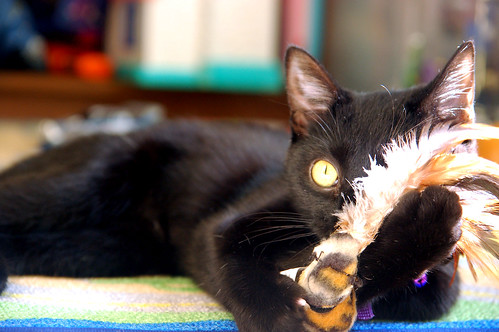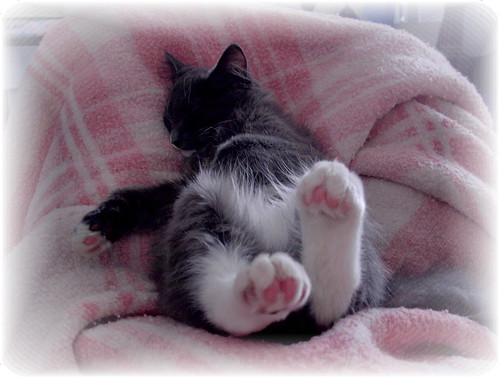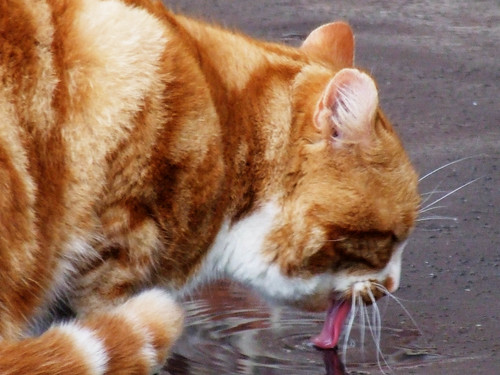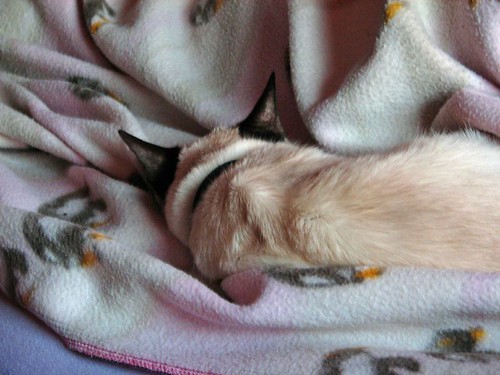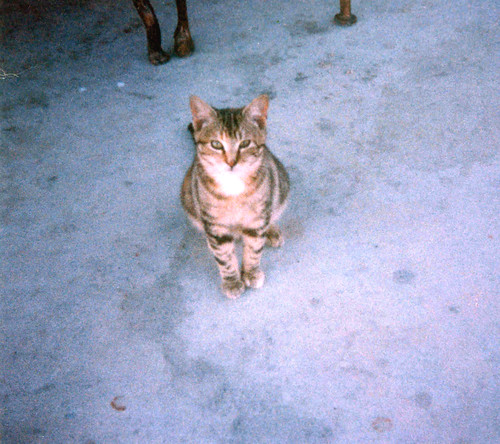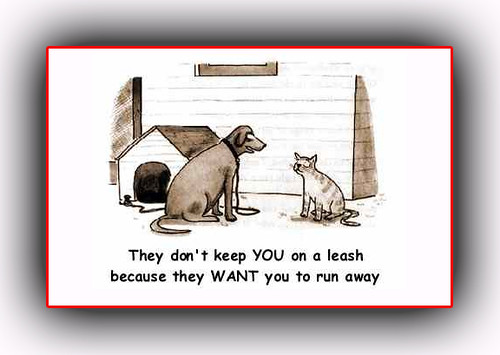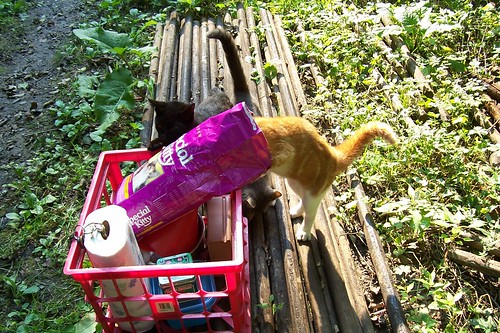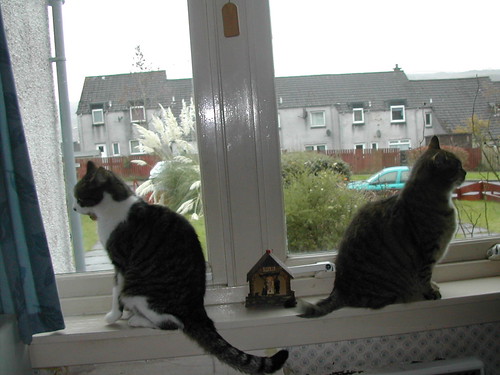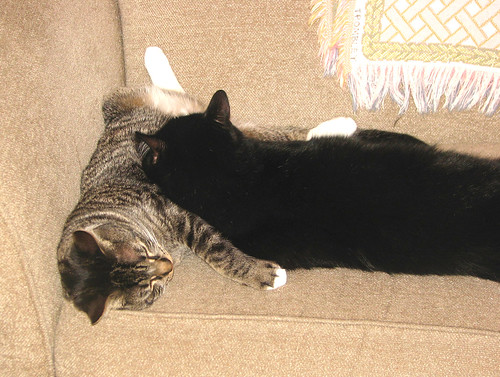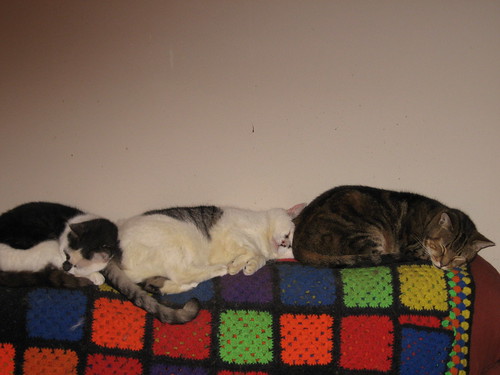Successful Cat Training - 3 Rules To Follow
 Cat training is not always easy, but it is possible. Though your cat may seem too independent and stubborn to change its behavior, you can get the job done if you make a commitment to the right strategies.
Cat training is not always easy, but it is possible. Though your cat may seem too independent and stubborn to change its behavior, you can get the job done if you make a commitment to the right strategies.
There are a few basic tents of successful training about whichever cat owner should be aware. Let us look at three of those cat training fundamentals:
The Need for Immediacy
Cats are incredibly smart animals, but they do not necessarily make the same kind of connections people do with respect to cause and effect. That is why it is essential to take action immediately when you observe inappropriate behavior. If your response is delayed by even a few seconds, it will lose a great deal of its effectiveness.
Never assume that your cat will remember what it did earlier in a day or that the cat will make any connection between your discipline and past behavior. Rarely, if ever, will that happen. If you correct your pet for something it did earlier, it will have no idea of why it is being corrected and may incorrectly link your actions to the behavior displayed immediately before you took action.
Encouraging Alternative Behaviors
One of the best ways to teach your cat not to engage in an undesirable behavior is to encourage the animal to do something else instead. This strategy works even better when the encouraged behavior is completely incompatible with the undesired action. This technique works because cats, like all animals, are more responsive to positive reinforcement.
You will have greater success encouraging and rewarding what you would like to see than you will by trying to stop what you do not. Instead of discouraging your cat from scratching a table leg, encourage your pet to exercise that instinct on its scratching post!
Avoiding Physical Discipline
Physical punishment will not contribute to successful cat training. Negative reinforcements do not work well for cats and hitting or otherwise physically reprimanding your pet will only make your relationship more difficult while inspiring unnecessary fear in the animal.
Cats are not always the easiest animals to train, but if one approaches the project with the right attitude and strategies, it is possible to direct a cat's behavior. The three elements of cat training we've discussed all share features common to all successful techniques--they are all based on the understanding that positive reinforcement offers the greatest chance of success and that cat owners should always use the least aggressive means of correcting behavior.
Those three rules of thumb are at the very core of smart cat training.
------------
Liz Barton
Cat Training
Article photo source
Novice kitten herding
master cat shepherd~
concentration and control~
kittens learn to flock
by foxfjord
Kitten Bad Breath
 Kitten bad breath is not a common problem for new kitten owners, but some people do find that their kittens breath smells bad. Not surprisingly, bad breath in cats and kittens can be caused by the same things that cause halitosis in humans - gum or dental problems, respiratory problems, or underlying disease. There are also a few things particular to cats that can cause an unpleasant odor on the breath.
Kitten bad breath is not a common problem for new kitten owners, but some people do find that their kittens breath smells bad. Not surprisingly, bad breath in cats and kittens can be caused by the same things that cause halitosis in humans - gum or dental problems, respiratory problems, or underlying disease. There are also a few things particular to cats that can cause an unpleasant odor on the breath.
Feline bad breath is often caused by tartar build up on the teeth. Just like in dogs and humans, tartar on the teeth fosters the growth of oral bacteria that produce volatile sulfur compounds, airborne molecules that smell very unpleasant. Although tartar has not generally had time to accumulate enough to cause kitten bad breath, you should check the condition of your kitten's teeth and gums to be sure there is no tartar or inflammation there. If you see signs of trouble, a trip to the vet is probably in order.
Respiratory problems can also be a cause of kitten bad breath. This is usually easy to pinpoint because it will be accompanied by signs of respiratory illness. Again, like humans and dogs, cats can get viral or bacterial infections of the nasal passages, throat and lungs. In turn these infections can encourage the growth of bacteria and may cause feline bad breath. If your cat has a respiratory infection accompanied by bad breath, the breath problem should resolve as soon as the cat recovers.
Another unusual cause of feline bad breath can be underlying illness - some metabolic disorders and organ problems such as kidney disease can cause an unusual odor on the breath. In most cases, the odor will not the typical sulfur smell of classic halitosis, but may still be quite unpleasant. A kitten bad breath problem that can't be attributed to any other common cause may be a sign that your kitten has a more serious problem that should immediately be assessed by a vet.
One cause of feline bad breath that is particular to cats is feline acne. If your cat has feline acne, you will see black specks or bumps on the cat's chin. These black spots are a buildup of secretions from the animal's glands, and the affected area can also be a site for the proliferation of colonizing bacteria. This unhealthy area can be the source of an unpleasant odor around the mouth, so part of your search for the cause of kitten bad breath should be an examination of your cat's chin. Feline acne can be treated with disinfectants: consult your vet for professional advice.
------------
R. Drysdale
Freelance Writer
Bad Breath Cure
Article photo source
Labels: Advices and Tips, Cat Health, Drugs, Kitten Bad Breath
Smily Cat
This is Belle, the cat that Santa brought the family (namely Anastasia). I just love the "Smile" on here face here.
By Light Saver
From Among Feathers
This is Belle, the cat that Santa brought the family (namely Anastasia). She's so fun to watch when she plays, and this is the first time I've been able to catch her still enough to photograph her.
By Light Saver
Cathedral Cat
A friendly ginger cat encountered just outside Durham Cathedral. Although this photo may suggest otherwise, Durham is not a Roman Cat-lick Cathedral.
By Ronald Hackston
Tips for a Healthy Pet Cat
 Proper Cat Health Tips
Proper Cat Health Tips
Proper cat health relies heavily on preventative measures; this includes routine veterinary care as well as grooming on a regular basis. To make sure you cat stays both happy and healthy it is a good idea to watch for any changes in their condition. An excellent time to monitor for cat health is during grooming sessions.
Cat Health According To Life Stages
The best way to keep on top of your cats health is by knowing the life stages and what proper cat health is for each stage. This way you can easily recognize when something is going wrong with your cats health and seek medical attention as soon as possible.
The first life stage is from birth of sixteen weeks. During this stage you cat is just starting to learn about the world around them. Cats in this stage are often playful but still shy around humans. Cat health is also extremely important in this stage so that they can grow up to be healthy throughout the rest of their life.
The next stage is from sixteen weeks to one year. During this period, cats are often still very playful. To maintain cat health you should make sure you cat is spayed or neutered at about six months old unless you are planning on using them as a breeding cat.
Next comes the one to eight year period, which are the prime years for cat health. During this stage of your cat's life, it is very important to have yearly visits to the veterinarian. From there is the eight to twelve year stage of a cats life. This is when pre-geriatric cat health comes into play. Your cat will often slow down but their behavior will remain the same.
Geriatric cat health will start when they turn twelve. At this age, you will start to notice health problems in your cat and they will often become worse as they age. Cats will often move very slowly since their joints will start to become stiff. Elderly cats may also be very irritated.
Common Cat Health Issues
There are varieties of health conditions that can affect your cat. A big part of keeping your cat healthy is proper prevention. Contact your veterinarian right away, if you notice any health problems. The following are some of the more common conditions your cat may get.
Flea allergy is a common problem for cats. A cat's sensitivity to fleabites will increase as they age. Food allergies can also have similar symptoms to fleabite allergies including dermatitis and severe itching, vomiting or diarrhea.
Hairballs are a persistent cause of vomiting in cats. You can reduce this issue by maintaining a regular schedule of coat brushing. Even with shorthair cats, they can get hairballs if you don't keep them down with routine brushing. You should take your cat into a veterinarian if they have persistent vomiting since this can also be a sign of thyroid or kidney problems.
-------------
Fred Long
Article photo source
thanks Fred :)
The cat is unimpressed
However, the cat is noteably unimpressed by the spectacular sunrise.
And yes, she is sleeping on a penguin bankie.
By singingpixel
Sweet sleep though :)
Attack Cat!
This kitty was named "Attack Cat" by my friends. Apparently it always was in pounce position. I had this beautiful kitty for about 15 years before he "disappeared".
By ArchChef
15 years companionship with such lovely kitty. That should have been wonderful!
Pray for the health of our kittens :o)
Specially Cheetara & the little guest Pooh. They have haemobartonella.
by Douglas Dickel
rabah
Special Kitty
Peter dives into the bag of "Special Kitty" kitten chow when I put the milk crate down.......to go back to the car.
He opened the bag and just dove right in. Paul is underneath him and the black barn cat is waiting it's turn too.
by lat454205/Lisa
How To Help Your Cat With Arthritis
 Cats can suffer from arthritis just as we humans do, and it mostly affects older cats. There might not be any cure (depending on the type of arthritis), but there are always treatments. Most cats are naturally exceptionally nimble and athletic animals, but as you might expect their joints, ligaments and bones are susceptible to accidental damage, and to the wear and tear of everyday life. On the other hand, giving thanks to their buoyancy, sense of balance, ability to land on their feet and built-in shock absorbers - their forelegs are not connected by bone to the rest of their skeleton, cats do not suffer from as many orthopaedic troubles as they might if they didn't have all of these great qualities. Arthritis conditions in cats take place most generally as an end result of accidents.
Cats can suffer from arthritis just as we humans do, and it mostly affects older cats. There might not be any cure (depending on the type of arthritis), but there are always treatments. Most cats are naturally exceptionally nimble and athletic animals, but as you might expect their joints, ligaments and bones are susceptible to accidental damage, and to the wear and tear of everyday life. On the other hand, giving thanks to their buoyancy, sense of balance, ability to land on their feet and built-in shock absorbers - their forelegs are not connected by bone to the rest of their skeleton, cats do not suffer from as many orthopaedic troubles as they might if they didn't have all of these great qualities. Arthritis conditions in cats take place most generally as an end result of accidents.
Cats can suffer from different kinds of arthritis, which plainly means joint inflammation. However, arthritis is much more compound than a simple inflammation, so this plain name is relatively confusing. For example, check out the wide range of signs of arthritis in cats:
- Stiffness
- Limping
- Favoring One Limb (especially after resting)
- Not Wanting to Climb Stairs or Jump
- Noticeable Pain
- Different Gait than Usual
- Nervousness
- Aggression * Depression
If you notice more than one of these symptoms in your cat, you should make an appointment with your veterinarian as soon as possible. Usually, as the owner, you notice these things right away and know that something isn't quite right.
Causes
Many things can cause arthritis in cats. Main reasons are old age, trauma, infections, immune system disorders and even developmental disorders.
Cats most commonly suffer the following two forms of arthritis. One is traumatic Arthritis and this may be caused by a sudden injury to a joint, such as following a vehicle accident, the consequence of a fight or play with another cat or animal, or because of an awkward fall.
The second is called osteoarthritis. Osteoarthritis is well thought-out by professionals to be the end result of a joint failure that can occur for nearly any reason. Cats' shoulder and elbow joints are those most regularly pretentious in older cats. Common causes are repeated episodes of traumatic arthritis, and also joint dislocation or fractures involving joints that occurred in the past and made the joints more vulnerable to disproportionate wear and tear.
What to Expect During Your Trip to the Vet
Your vet will conduct a regular examination, and comments from you on your cat's problems. Your vet might take some tests to rule out anything else such as blood tests, radiographs, ultrasound, etc.
Treatments
If your cat is diagnosed with arthritis, there are many treatments available. Some you can do at home such as gentle massage, weight control, exercise, and warmth. Some medications may be prescribed for your cat such as Glucosamine and Chondroitin, Corticosteroids, Vitamin C, and/or NSAIDs (Non-steroidal Anti-inflammatory Drugs).
There are numerous different kinds of joint diseases that your cat could have, too. These include:
Feline progressive polyarthritis (which affects more than one joint) Dysplasia Bacterial Arthritis Oseoarthritis (Degenerative Joint Disease) Ruptured Anterior Cruciate Ligament Luxating Patella Hip Dysplasia Intervertabral Disc Disease Hyperparathyroidism
Although most forms of arthritis has no cure to rid your feline of the disease, there are plenty of treatments available. Your cat can live out the rest of his or her life with less pain, more activity, and just being generally happier!
--------------
Jean Morgan
Natures Healthy Pet
photo source
Understanding Kidney Disease In Cats
 Kidney disease in older cats is especially worrisome. It is also known as chronic renal failure and is a common problem in older cats. It is seen in cats of all ages, but mostly older cats.
Kidney disease in older cats is especially worrisome. It is also known as chronic renal failure and is a common problem in older cats. It is seen in cats of all ages, but mostly older cats.
Symptoms of Kidney Disease in Cats
* Your cat is drinking much more water than usual
* Your cat is urinating much more than usual
These will be the most noticeable symptoms for you and your cat. When the kidney is not functioning properly, it can't concentrate your cat's urine. However, your veterinarian will probably conduct some blood tests just to rule out any other illness, as this can be a sign of another illness.
Unfortunately, the symptoms don't usually become apparent until about three quarters of the kidney is already in failure. Just as unfortunate is the fact that kidney disease (chronic renal failure) in cats has no cure or way of reversing the damage. The disease will continue, but there are ways you can make your cat more comfortable in the years she has left.
Treatment can include the following
1. Diet: You might hear or read things that suggest certain special diets for your cat. However, the most important thing is that your cat is eating. If your cat doesn't like the diet and refuses to eat the food, it doesn't do much good. Feed your cat the foods she likes to eat, staying with nutritional, healthy foods. Don't feed your cat just dry food. They will need the moisture from other foods to help keep them hydrated.
2. Nutrition: Your veterinarian might suggest a special food called Renafood, which can help better your cat's kidney function. You might need to crush it into your cat's regular food, but most cats actually like it.
3. Supplemental Fluids: Your veterinarian can give your cat supplemental fluids at their office or teach you how to do it at home. This is one of the best ways to keep your cat hydrated.
There are many ways to help you help your cat live out a happier and healthier life and the most important part of that is keeping them hydrated. Your cat's kidneys can no longer keep the water because of the damage that is already there and it can't be reversed. Ask your veterinarian what else you can do to keep her hydrated, because this will in turn keep her more comfortable. Your vet might suggest some homeopathy, herbs, flower essences and/or acupuncture to help make your cat feel better.
Your vet may also suggest some medicines to help. There are some that can help, just make sure you have all of the information on them (including side effects) in case you find your cat may have some unwanted effects from them.
-------------
Jean Morgan
Natures Healthy Pet
photo source
Labels: Cat Health, Cat Kidney Disease, Cat Nutrition, Cat Urine


